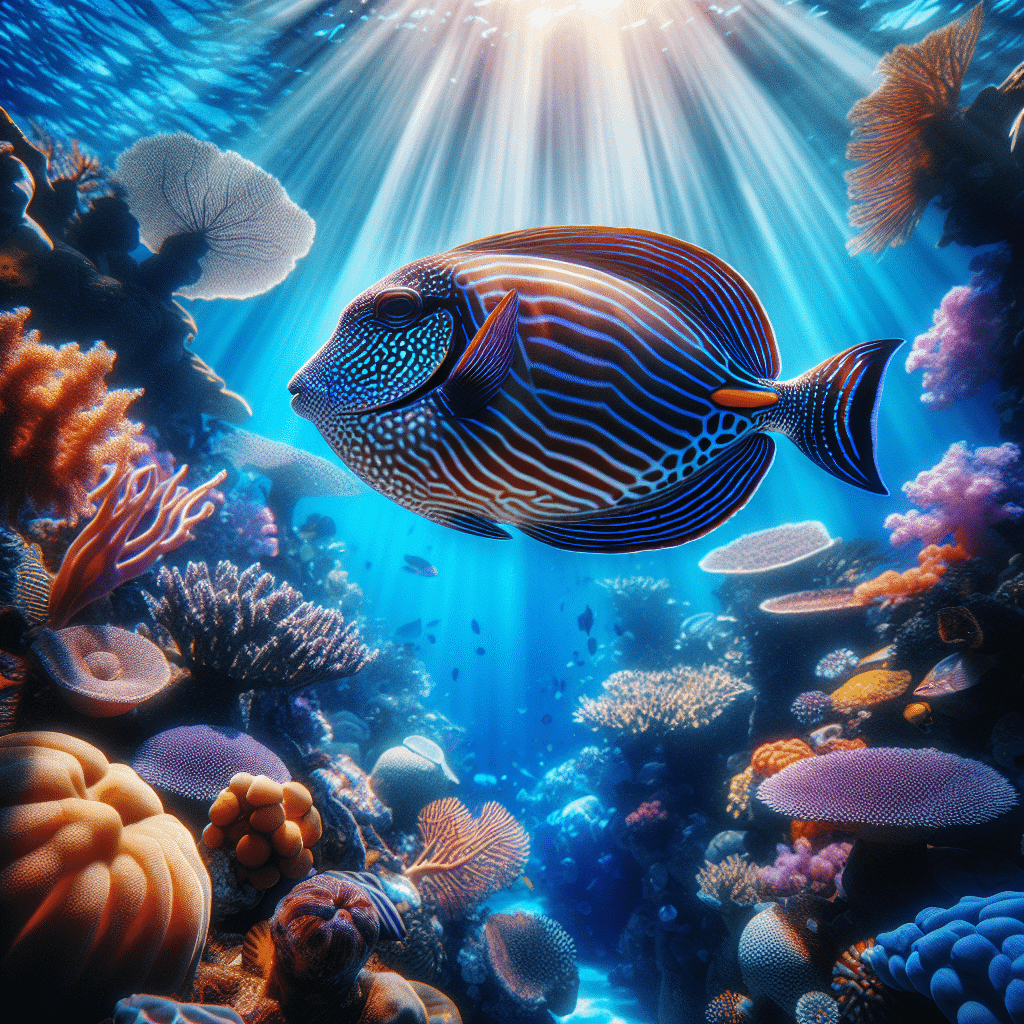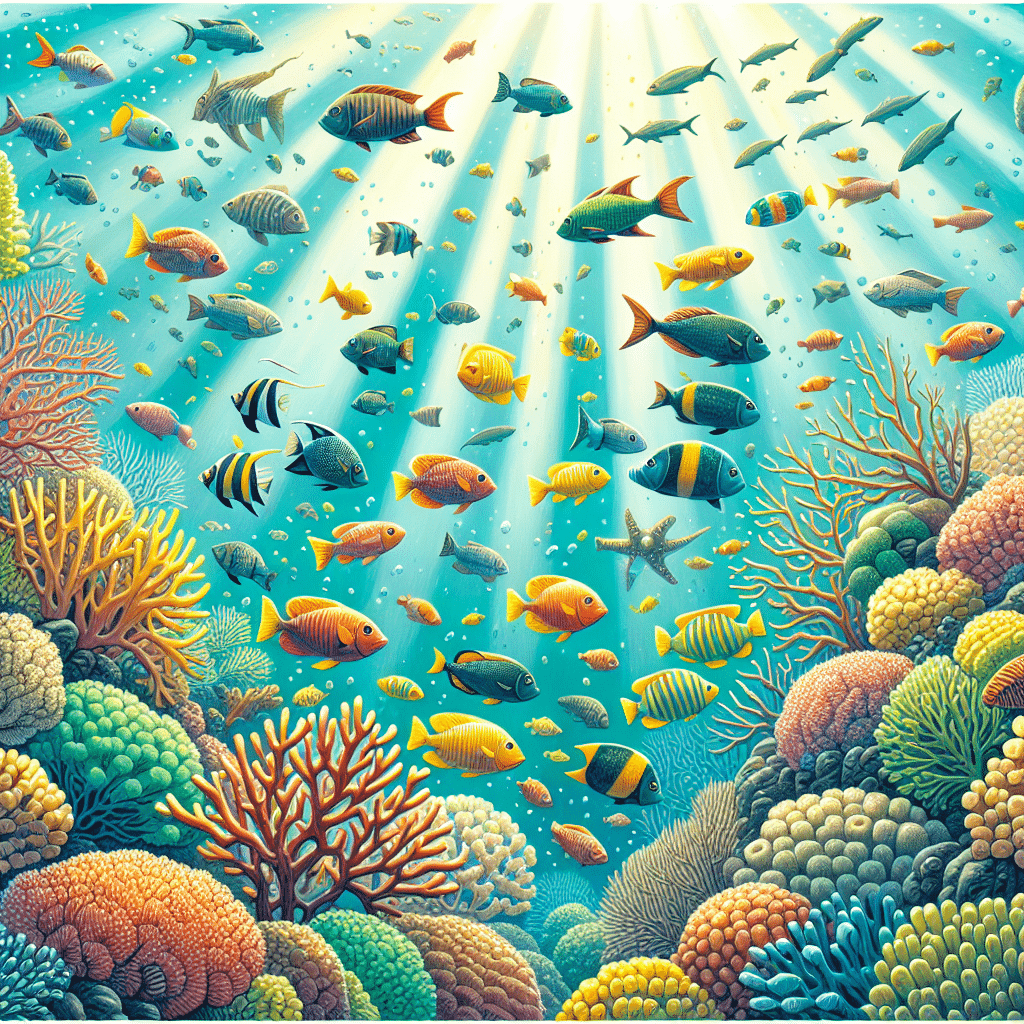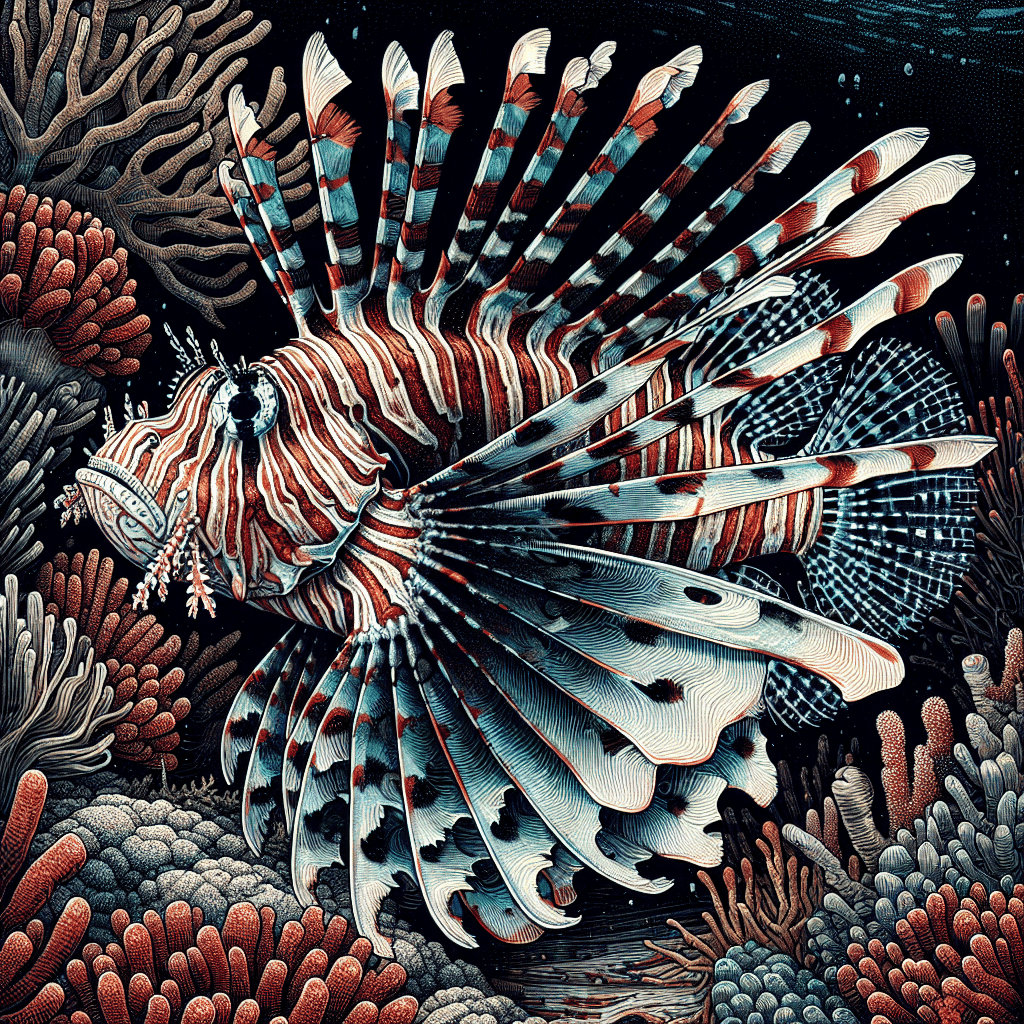Reef Tank Fish: Sailfin Tang
Introduction to Sailfin Tang
As a fish tank hobbyist, I find the Sailfin Tang, scientifically known as Zebrasoma velifer, to be a fascinating addition to any marine aquarium. This species is known for its striking appearance and lively behavior, making it a favorite among aquarists. Sailfin Tangs are mainly herbivores, thriving on a diet rich in leafy macroalgae in their natural habitat. They are fairly easy to care for and can adapt well to a variety of tank environments, whether it’s a reef setup or a fish-only tank.
Tank Requirements for Sailfin Tang
When it comes to housing a Sailfin Tang, tank size is crucial. The minimum recommended tank size for a Sailfin Tang is typically 6 feet in length (Reef2Reef). This spacious environment allows them to swim freely and establish their territory, which is important for their well-being.
Here are some key tank requirements for keeping Sailfin Tangs:
| Requirement | Details |
|---|---|
| Tank Size | Minimum 6 feet (180 gallons or more) |
| Water Quality | Stable salinity, pH 8.1-8.4, temperature 72-78°F (22-26°C) |
| Filtration | High-quality filtration system to maintain water clarity and quality |
| Decor | Rock formations and hiding spots to mimic natural habitat |
| Tank Mates | Can be kept with other peaceful fish; monitor for territorial behavior |
Sailfin Tangs are relatively disease-resistant, but they do thrive in a habitat that offers good water quality and compatible tank mates. They can coexist with a variety of species, but it’s best to avoid aggressive fish to prevent stress. If you’re considering other fish for your tank, check out options like clownfish or goby for peaceful companions.
Overall, with proper care and attention to their environment, Sailfin Tangs can be a vibrant and dynamic component of your reef tank.
Biology of Sailfin Tang
Scientific Classification of Sailfin Tang
The sailfin tang, scientifically known as Zebrasoma velifer, is a fascinating member of the reef tank community. It’s categorized under the Genus Zebrasoma and was first described by Bloch in 1795. This species is notable for its vibrant appearance and is often a favorite among hobbyists.
Here’s a quick breakdown of its classification:
- Common Name: Sailfin Tang
- Scientific Name: Zebrasoma velifer
- Genus: Zebrasoma
- Family: Acanthuridae
For more detailed information on its classification, check out the FishBase.
Physical Characteristics of Sailfin Tang
The sailfin tang is easily recognizable due to its unique physical traits. Adult individuals can grow up to 39.5 cm long and exhibit a deep, compressed body. The body depth is about 1.8 to 2.0 times shorter than the standard length. The head has a concave dorsal and ventral profile, which adds to its distinctive look.
Here are some notable physical features:
| Feature | Description |
|---|---|
| Body Shape | Deeply compressed |
| Dorsal Fin | Continuous, unnotched; 29 to 33 rays; 4 to 9 spines |
| Anal Fin | 23 to 26 rays; 2 or 3 spines |
| Pectoral Fins | 15 to 17 rays |
| Teeth | Up to 16 upper and 18 lower teeth |
These characteristics make the sailfin tang not only a striking addition to any aquarium but also an interesting species to observe. For those interested in marine life, the sailfin tang is a perfect example of the diversity found in the ocean. If you’re also curious about other species, take a look at marine fish or other related species like blue tang and yellow tang.
Habitat and Distribution
Native Range of Sailfin Tang
The sailfin tang, scientifically known as Zebrasoma veliferum, has a fascinating native range that stretches across the Pacific Ocean. I find it interesting that these fish can be found from Indonesia and Christmas Island all the way to the Hawaiian and Tuamotu Islands. They also inhabit areas north to southern Japan and south to regions like the southern Great Barrier Reef, New Caledonia, and Rapa. Additionally, they are present throughout Micronesia (Animal Diversity Web).
Here’s a quick overview of the sailfin tang’s native range:
| Region | Notable Locations |
|---|---|
| Pacific Ocean | Indonesia, Christmas Island |
| Hawaiian Islands | Hawaiian Islands |
| Tuamotu Islands | Tuamotu Islands |
| East Asia | Southern Japan |
| South Pacific | Southern Great Barrier Reef, New Caledonia, Rapa |
| Micronesia | Various Islands |
Environmental Preferences of Sailfin Tang
When it comes to environmental preferences, sailfin tangs thrive in coral reef habitats, which provide them with plenty of food and shelter. They prefer warm, shallow waters with ample rock formations and coral. This environment not only offers hiding spots but also a diverse range of algae for them to graze on.
I’ve learned that sailfin tangs are often found at depths of about 1 to 30 meters (3 to 98 feet). They enjoy areas with moderate water flow and good light penetration, which supports the growth of the algae they love to munch on.
Here’s a summary of their environmental preferences:
| Preference | Description |
|---|---|
| Habitat Type | Coral reefs, rocky substrates |
| Depth | 1 to 30 meters (3 to 98 feet) |
| Water Temperature | Warm, typically between 24°C to 28°C (75°F to 82°F) |
| Light | Areas with good light penetration |
| Water Flow | Moderate water flow |
Understanding the sailfin tang’s natural habitat and distribution can help me create a more suitable environment in my reef tank. If you’re looking to add a sailfin tang to your aquarium, ensure you replicate their natural conditions as closely as possible for optimal health and behavior. For more insights on various fish species, check out our section on marine fish.
Feeding Habits
Natural Diet of Sailfin Tang
The Sailfin Tang, scientifically known as Zebrasoma velifer, is primarily a herbivore. In its natural habitat, it mainly feeds on leafy macroalgae and benthic algae. Occasionally, when zooplankton is abundant, it will also consume that as part of its diet (Animal Diversity Web). This preference for plant material means that in the wild, Sailfin Tangs spend a lot of time grazing on the ocean floor, looking for the best algae to munch on.
Here’s a quick overview of what Sailfin Tangs typically eat in the wild:
| Food Type | Description |
|---|---|
| Leafy Macroalgae | Primary food source |
| Benthic Algae | Commonly consumed during grazing |
| Zooplankton | Occasionally eaten when abundant |
Feeding Sailfin Tang in Captivity
Feeding Sailfin Tangs in captivity can be a rewarding experience, but it’s important to mimic their natural diet as closely as possible. These fish require a diet rich in vegetable matter alongside some meaty foods. A well-rounded diet for Sailfin Tangs should include a mix of the following:
- Marine Algae: This is a staple food. Nori sheets or other dried seaweeds are great options.
- Spirulina: A type of blue-green algae that is high in protein and essential nutrients.
- Frozen Foods: Mysis shrimp, brine shrimp, and other frozen marine foods can be offered to provide variety.
- Flake Foods: High-quality flake foods formulated for herbivores can supplement their diet.
- Vitamin Supplements: Adding vitamins, particularly vitamin C, can help maintain their health and vitality.
Here’s a simple feeding schedule I like to follow:
| Feeding Time | Food Type | Frequency |
|---|---|---|
| Morning | Marine algae (Nori) | Daily |
| Afternoon | Frozen mysis or brine shrimp | 3-4 times a week |
| Evening | Spirulina flakes | Daily |
By providing a balanced diet, I ensure my Sailfin Tang stays healthy and vibrant. Remember to observe your fish during feeding to see what they prefer and adjust their diet accordingly. For more information on keeping various fish, check out our articles on marine fish and specific types like tang and clownfish.
Care and Maintenance
Keeping Sailfin Tang in Aquariums
I’ve found that keeping a Sailfin Tang in my aquarium is a rewarding experience. This species, known scientifically as Zebrasoma velifer, is relatively easy to care for. It’s important to ensure that the tank is spacious enough, with a minimum recommended length of 6 feet (Reef2Reef). Sailfin Tangs thrive in environments that maintain consistent water quality, making them a great addition to a marine aquarium, whether it’s a reef setup or a fish-only tank.
Here are some key care tips for keeping Sailfin Tangs:
| Care Aspect | Details |
|---|---|
| Tank Size | Minimum 6 feet in length |
| Water Quality | Maintain stable parameters (salinity, pH, ammonia) |
| Diet | Herbivorous; requires vegetable matter, algae, and vitamin supplements |
| Disease Resistance | Highly resistant but requires good care |
I recommend providing a varied diet that includes leafy macroalgae, prepared frozen formulas, spirulina, and even some meaty foods like mysid shrimp and brine shrimp. This diversity helps meet their nutritional needs and keeps them healthy.
Breeding and Sexual Dimorphism
Interestingly, Sailfin Tangs have not yet been bred in captivity, but sightings of breeding pairs in the ocean have been reported. Most of the time, sexual differences in Zebrasoma species aren’t well documented, but it’s noted that males tend to grow larger than females. This can be a good indicator when selecting potential mates for breeding.
If you’re considering breeding Sailfin Tangs, ensure that you have enough space and the right conditions to encourage natural behaviors. They enjoy a stable environment with plenty of hiding spots and plenty of swimming space. For more on keeping different types of marine fish, check out our articles on marine fish and specific species like blue tang and yellow tang.
Behavior and Compatibility
Territorial Behavior of Tangs
The Sailfin Tang, like many tangs and surgeonfish, has a reputation for being territorial. They can exhibit aggressive behavior not only towards their own species but also to other fish, especially if they feel their space is being invaded. I’ve noticed that it’s essential to understand their social dynamics when setting up a tank. Tangs often thrive in environments where they have enough room to establish their territory without frequent disturbances.
When introducing new fish, I always keep an eye on how the Sailfin Tang behaves. It’s best to add new tank mates gradually and monitor interactions closely. If you’re considering adding other tangs, it might be wise to introduce them simultaneously to reduce territorial disputes. Some compatible fish include those that are more placid, as this helps maintain harmony in the tank.
Tankmate Compatibility with Tangs
In my experience, Sailfin Tangs can coexist peacefully with a variety of fish, provided those tankmates are compatible. They do well in a fish-only public tank or a reef environment, without posing any threat to invertebrates or corals. It’s crucial to choose tank mates that are mild-tempered and not overly aggressive.
Here’s a quick reference table for some compatible tank mates for Sailfin Tangs:
| Compatible Fish | Notes |
|---|---|
| Clownfish | Peaceful and social; usually get along well. |
| Royal Gramma | Small and non-aggressive; good tank mate. |
| Cleaner Wrasse | Helps keep the tank clean and is non-territorial. |
| Blenny | Non-aggressive herbivores that get along well. |
| Butterfly Fish | Generally peaceful; but watch for nipping. |
On the other hand, it’s best to avoid keeping multiple tangs in the same tank unless the aquarium is large enough to provide distinct territories. Members of their own genus can lead to conflicts, so introducing other species that don’t compete for the same space can be beneficial.
In conclusion, keeping Sailfin Tangs with the right tank mates can lead to a thriving aquarium. Maintaining a balanced environment with careful monitoring of behaviors will ensure a peaceful coexistence among your fish. For more information on other marine fish, check out our section on marine fish.
Yellow Tang: Profile
Overview of Yellow Tang
The Yellow Tang, often referred to as the Yellow Sailfin Tang, is one of the most popular aquarium species worldwide. Its vibrant yellow color, hardiness, and relatively low cost make it an attractive choice for many hobbyists (Who Gives a Fish). These fish have a unique disk-shaped appearance, especially when their fins are fully extended. They’re known for being bold, curious, and active during the day, which adds life to any tank.
Yellow Tangs are herbivores, primarily feeding on filamentous algae in their natural habitat. In a home aquarium, they thrive on a diet that includes marine algae, spirulina, frozen brine, mysis shrimp, flake foods, and live rock that contains micro and macro organisms (Who Gives a Fish). They can be kept in both fish-only tanks and reef environments, making them versatile for different setups.
| Characteristic | Description |
|---|---|
| Common Name | Yellow Tang |
| Scientific Name | Zebrasoma flavescens |
| Color | Bright yellow |
| Diet | Herbivore |
| Tank Compatibility | Mild-tempered, can coexist with most fish except other tangs |
Lifespan and Behavior of Yellow Tang
In terms of lifespan, Yellow Tangs can live between 5 and 10 years in an aquarium setting. They are slow-growing and tend to thrive in a quality environment (Who Gives a Fish). Their behavior is generally peaceful, allowing them to integrate well with a variety of tankmates, which is a significant plus for hobbyists looking to build a diverse aquatic community.
However, it’s essential to keep in mind that they may display territorial behavior towards other tangs. Therefore, if you’re planning to add a Yellow Tang to your tank, it’s best to avoid introducing other members of the same genus. Their active nature and interesting personalities make them a delightful addition to any reef tank.
For more information on other tangs, check out our article on tang species.
Feeding Yellow Tang
Natural Diet of Yellow Tang
The Yellow Tang, like its cousin the Sailfin Tang, is primarily an herbivore. In the wild, it mainly feeds on filamentous algae and leafy macroalgae. This diet is crucial for their health, as it provides the necessary nutrients to thrive in a marine environment. I’ve found that understanding their natural diet helps in replicating it in a home aquarium setting.
Feeding Yellow Tang in Aquariums
When it comes to feeding Yellow Tangs in an aquarium, it’s vital to provide a varied diet that mimics their natural feeding habits. Here’s a quick breakdown of what to include in their diet:
| Food Type | Description |
|---|---|
| Marine Algae | Leafy and filamentous varieties are best. |
| Spirulina | A great source of nutrients and fiber. |
| Frozen Foods | Mysis shrimp and brine shrimp are excellent choices. |
| Flake Foods | Look for high-quality options that contain vegetable matter. |
| Vitamin Supplements | Adding vitamin C can enhance their overall health. |
Offering a mix of these foods will help ensure that your Yellow Tang gets all the essential nutrients. It’s also a good idea to include live rock in the tank, as it hosts micro and macro organisms that the tang can graze on.
Yellow Tangs are relatively easy to care for, and they adapt well to aquarium life as long as their dietary needs are met. For more information on keeping these beautiful fish, check out our guide on marine fish.
Care Tips for Yellow Tang
Housing Yellow Tang in Tanks
When setting up a tank for a Yellow Tang, I always make sure to choose a spacious aquarium. A minimum of 75 gallons is typically recommended to accommodate their active swimming behavior. These fish thrive in a well-maintained environment with stable water quality, so regular monitoring of parameters like pH, salinity, and temperature is essential. I prefer a temperature range of 72°F to 78°F along with a specific gravity of 1.020 to 1.025.
Yellow Tangs can be kept in both reef environments and fish-only tanks, and they do not harm invertebrates or corals. The tank should have plenty of hiding spots and open swimming areas. Using live rock and appropriate decorations can help mimic their natural habitat and reduce stress.
| Tank Size | Recommended Gallons |
|---|---|
| Minimum | 75 |
| Optimal | 100+ |
Compatibility and Disease Resistance
Yellow Tangs are generally mild-tempered and can get along with most fish, making them great additions to a community tank. However, they can be territorial, especially towards other tangs. I find it important to introduce tankmates carefully to avoid conflicts. Opt for peaceful species that are not members of the tang family to enhance compatibility.
These fish are highly resistant to disease and respond well to treatment if they fall ill, which is a plus for many hobbyists. Their natural curiosity and active lifestyle make them social and engaging to observe in a tank setting. For more information on other compatible species, check out our section on marine fish.
| Fish Type | Compatibility |
|---|---|
| Peaceful Species | Good |
| Other Tangs | Poor |
| Non-aggressive Fish | Good |
Keeping these tips in mind can help ensure that your Yellow Tang thrives in your aquarium. They can live between 5 to 10 years, so with the right care, you’ll enjoy their vibrant presence for a long time (Who Gives a Fish).



